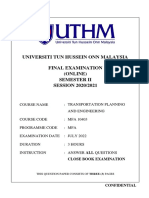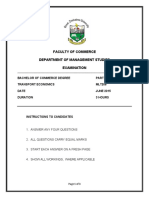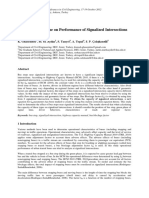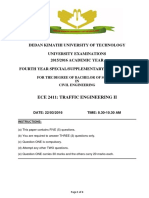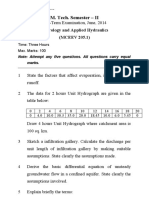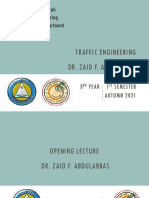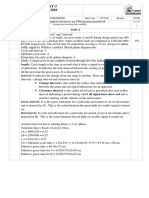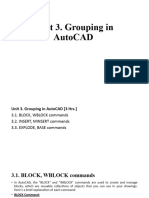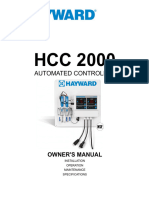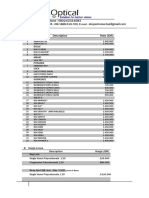0 ratings0% found this document useful (0 votes)
10 views2019 PT Final
2019 PT Final
Uploaded by
Rmesh jhaThis document provides information about a final exam for a Master's level Transportation Engineering and Management course. The exam contains 7 questions related to public transportation planning and management. It covers topics such as public transportation infrastructure development, mode choice modeling, mass transit planning, transport policy development, traffic forecasting, and investment appraisal techniques for transportation projects. Students are required to answer all questions in their own words and can assume suitable data if necessary. The exam is out of a total of 100 marks and students must score at least 60 marks to pass.
Copyright:
© All Rights Reserved
Available Formats
Download as PDF, TXT or read online from Scribd
2019 PT Final
2019 PT Final
Uploaded by
Rmesh jha0 ratings0% found this document useful (0 votes)
10 views2 pagesThis document provides information about a final exam for a Master's level Transportation Engineering and Management course. The exam contains 7 questions related to public transportation planning and management. It covers topics such as public transportation infrastructure development, mode choice modeling, mass transit planning, transport policy development, traffic forecasting, and investment appraisal techniques for transportation projects. Students are required to answer all questions in their own words and can assume suitable data if necessary. The exam is out of a total of 100 marks and students must score at least 60 marks to pass.
Original Description:
pokhara university old qs
Copyright
© © All Rights Reserved
Available Formats
PDF, TXT or read online from Scribd
Share this document
Did you find this document useful?
Is this content inappropriate?
This document provides information about a final exam for a Master's level Transportation Engineering and Management course. The exam contains 7 questions related to public transportation planning and management. It covers topics such as public transportation infrastructure development, mode choice modeling, mass transit planning, transport policy development, traffic forecasting, and investment appraisal techniques for transportation projects. Students are required to answer all questions in their own words and can assume suitable data if necessary. The exam is out of a total of 100 marks and students must score at least 60 marks to pass.
Copyright:
© All Rights Reserved
Available Formats
Download as PDF, TXT or read online from Scribd
Download as pdf or txt
0 ratings0% found this document useful (0 votes)
10 views2 pages2019 PT Final
2019 PT Final
Uploaded by
Rmesh jhaThis document provides information about a final exam for a Master's level Transportation Engineering and Management course. The exam contains 7 questions related to public transportation planning and management. It covers topics such as public transportation infrastructure development, mode choice modeling, mass transit planning, transport policy development, traffic forecasting, and investment appraisal techniques for transportation projects. Students are required to answer all questions in their own words and can assume suitable data if necessary. The exam is out of a total of 100 marks and students must score at least 60 marks to pass.
Copyright:
© All Rights Reserved
Available Formats
Download as PDF, TXT or read online from Scribd
Download as pdf or txt
You are on page 1of 2
Pokhara University
Final Examination, Fall 2019
Level: MSc. Full Marks: 100
Program: Transportation Engineering and Management Pass Marks: 60
Course: TRP 713.3 Public Transportation Planning and Management Time: 4 hrs.
Year/Semester: II/I
Candidates are required to give their answers in their own words as far as possible. The figures in the
margin indicate Full Marks. Assume suitable data if necessary.
Attempt ALL Questions.
1) a) Elaborate public transportation infrastructure development in Nepalese context and explain the
areas for its improvements. [5]
b) There are four types of users in a city who commute regularly between the residential area and
work center. The mode choice utilities worked out for four types of modes: Automobile (A),
BRT, Buses (B) and Monorail (MR) with the utility function (U), cost (C) and travel time (T)
are presented in the table.
Function Cost (C) (Dollars) Travel Time (T) (Minutes)
U(A) = 3.2 – 0.3 C – 0.04 T 5 30
U(BRT) = 1 – 0.3 C – 0.04 T 3 25
U(B) = 0 – 0.1 C – 0.01 T 2.5 40
U(MR) = 1.5 – 0.3 C – 0.05 T 6 20
(i) Based on study that 10,000 commuters leave for work center each morning, how many
commuters will choose to take a particular mode?
(ii) If government subsidies BRT by 30%, Buses by 20% and Monorail by 10% and the same
time increases automobile cost by 15%, what will be the new modal distribution?
(iii) What happens to the modal split if time of auto is increased to 35 minutes due to forced
congestion? [10]
OR
Differentiate between vehicle scheduling and crew scheduling? How do you see its importance
in Nepalese context? Elaborate in detail with suitable examples. [2 + 3 + 5]
2) a) What is mass transit? How such systems are planned and what are the factors involved?
b) What are the factors that plays important role in the preparation of transport policy? How do
you see the Nepalese transport policy in term of public transportation development and
operation? [5 + 5]
3) a) Why is traffic forecasting important and elaborate the issues in forecasting public transportation
in Nepalese context? [5]
b) On a city street a bus route is scheduled for 5 minutes headways. On the average, 10 passengers
per bus board at a particular stop and 4 passengers alight. All boarding passengers use the front
door and alighting passengers use the back door. Time to open and close the doors is 3 seconds.
Assume clearance time is 15 seconds and the maximum allowable probability of bus queuing is
7.5%. The stop is a near-side at an intersection with a g/C ratio of 0.50. How many loading areas
are required? [10]
4) The trips produced and attracted of three traffic zones are as follows:
Zones 1 2 3 Total
Trips Produced 14 33 28 75
Trips Attracted 33 28 14 75
The travel time matrix in minutes amongst three traffic zones are presented in the table.
Travel Time Matrix (minutes) To Zone
From Zone 1 2 3
1 1 8 4
2 6 2 7
3 4 7 2
The impedance and corresponding frictional factors have been calibrated as follows.
Impedance (Travel time in minutes) 1 2 3 4 5 6 7 8
Frictional Factors 82 52 50 41 39 26 20 13
Distribute the trips between the traffic zones assuming socio-economic factor as 1. Perform only
two iterations. [15]
OR
What are the investment appraisal techniques? Describe the factors involved in investment
appraisal of transportation projects. Explain briefly the evaluation criteria for major investment
study in the transportation sector. [2 + 5 + 8]
5) a) What is multi criteria analysis? How could it be used for investment appraisal and on providing
subsidies issues? [1 + 4]
b) Indicate the appropriateness between mid-block, near-side and far-side bus stops. Describe the
bus service design elements and factors. [4 + 6]
6) Consider a bus route that connects a residential area to a central business district (CBD). The
distance between the area and the CBD is 8.3 km. The average speed of buses is 20 kmph between
the two terminal points. It is planned to provide bus service at every 15 minutes along the route.
i) Determine the time required to travel from one end of the route to the other.
ii) Determine the number of vehicles required in order to operate at the desired level of service.
iii) Determine the capacity of the route if capacity per vehicle is 75 passengers.
iv) Determine the number of vehicles if forecasted demand for this transit route is 400 passengers
per hour at the peak loading point. [15]
OR
Critically examine the possibilities of mass transportation systems in Kathmandu valley. Describe
the strategies and actions involve in Mass Transport System Management (MTSM) in the supply
side. [5 + 10]
7. Write short notes on: Any Two [5 x 2 = 10]
a) Characteristics, benefits and challenges of public transportation
b) Public transport issues in developing countries and challenges of public transport policies
c) Use of different models in traffic forecasting
d) Compare among Logit model, Probit model and Nested logit model
You might also like
- Patterson Pump Company LTD: Model: 5x4x12 SSC Size: 5x4x12 Qty: 1Document25 pagesPatterson Pump Company LTD: Model: 5x4x12 SSC Size: 5x4x12 Qty: 1Ahmad Salah100% (2)
- Mfa10403 Final Exam - Sem 2 20212022Document3 pagesMfa10403 Final Exam - Sem 2 20212022hassan huseinNo ratings yet
- University of Mauritius University of Mauritius University of Mauritius University of MauritiusDocument4 pagesUniversity of Mauritius University of Mauritius University of Mauritius University of MauritiusAvinaash VeeramahNo ratings yet
- Traffic Engineering and ManagementDocument8 pagesTraffic Engineering and ManagementKrishnan ChockalingamNo ratings yet
- Urban Transportation PlanningDocument2 pagesUrban Transportation PlanningAynup IrahtakNo ratings yet
- TRE12A2Document7 pagesTRE12A2rrmonyaneNo ratings yet
- Mid Term Exam 2Document3 pagesMid Term Exam 2Refisa JiruNo ratings yet
- Ce407 2014 05Document4 pagesCe407 2014 05kundayi shavaNo ratings yet
- Ce6006 Traffic Enggineering and ManagementDocument10 pagesCe6006 Traffic Enggineering and ManagementBhat TalhaNo ratings yet
- Transportation EngineeringDocument2 pagesTransportation EngineeringMohammed AbidNo ratings yet
- BCE 4203 Traffic Engineering and Management (Midterm Exam) - 2022Document2 pagesBCE 4203 Traffic Engineering and Management (Midterm Exam) - 2022Delina TedrosNo ratings yet
- CH 23456Document50 pagesCH 23456NabeelSaleemNo ratings yet
- School of Civil Engineering and GeosciencesDocument3 pagesSchool of Civil Engineering and GeosciencesmkaswaNo ratings yet
- Past CIV343 QuestionsDocument3 pagesPast CIV343 QuestionsOba-Elvis IkenyenweNo ratings yet
- University of Bologna: Masters in Civil Engineering Sustainable Transportation Engineering (Time Allowed: TWO Hours)Document14 pagesUniversity of Bologna: Masters in Civil Engineering Sustainable Transportation Engineering (Time Allowed: TWO Hours)Sufian AbusninaNo ratings yet
- Module - 1, Continued. Traffic Parameter Studies and AnalysisDocument18 pagesModule - 1, Continued. Traffic Parameter Studies and AnalysisPraveen M balaramNo ratings yet
- Mock Exam, December 2011: Institute For Transport Studies (Its)Document4 pagesMock Exam, December 2011: Institute For Transport Studies (Its)gonggom100% (1)
- Cet436 ADocument3 pagesCet436 AivyshamjuNo ratings yet
- Null 5Document3 pagesNull 5FARAI KABANo ratings yet
- Transportation AssignmentDocument11 pagesTransportation AssignmentShane RodriguezNo ratings yet
- Service Level Benchmarking of Urban Transport For A Medium Sized CityDocument13 pagesService Level Benchmarking of Urban Transport For A Medium Sized CityBasilNo ratings yet
- Traffic EngineeringDocument4 pagesTraffic Engineeringy mugambiNo ratings yet
- ETC_Assignment-2Document2 pagesETC_Assignment-2Frency ButaniNo ratings yet
- LOS Paper Based On Service Delay at SSMDocument17 pagesLOS Paper Based On Service Delay at SSMtathagatha khanNo ratings yet
- Effect of Dwell Time On Performance of Signalized IntersectionsDocument23 pagesEffect of Dwell Time On Performance of Signalized IntersectionsAmul ShresthaNo ratings yet
- ECE 2411 SUPP Exam 2016 PRINTREADYDocument4 pagesECE 2411 SUPP Exam 2016 PRINTREADYKiprono VincentNo ratings yet
- Analysis of Major Transport CorridorsDocument58 pagesAnalysis of Major Transport Corridorslilikwbs9334No ratings yet
- Traffic Engineering Model PaperDocument2 pagesTraffic Engineering Model PaperMr. Y. RajeshNo ratings yet
- 07a70106 TrafficengineeringDocument5 pages07a70106 TrafficengineeringSamiullah MohammedNo ratings yet
- Railway Operation Analysis: Effective Railway Planning Through Operations Research ModelsDocument9 pagesRailway Operation Analysis: Effective Railway Planning Through Operations Research Modelspradyum kumarNo ratings yet
- PUC 3114 Project Assignment Work Aug 2023Document8 pagesPUC 3114 Project Assignment Work Aug 2023SKynet Movies Cyber PS4No ratings yet
- Ce - Ii - 1Document50 pagesCe - Ii - 1saurabh1116No ratings yet
- IAT-III Question Paper With Solution of 17CV751 Urban Transport Planning Jan-2021-Arunkumar YadavDocument25 pagesIAT-III Question Paper With Solution of 17CV751 Urban Transport Planning Jan-2021-Arunkumar YadavSrikanth ReddyNo ratings yet
- CHAPTER 2.0 StudentVersionDocument156 pagesCHAPTER 2.0 StudentVersionsyahmienashrafNo ratings yet
- Civ3703 S2 2018 Final PDFDocument13 pagesCiv3703 S2 2018 Final PDFHarsha N SandrinNo ratings yet
- Dr. Zaid - Traffic Eng. Opn. LectDocument17 pagesDr. Zaid - Traffic Eng. Opn. LectMOHAMEDALNAZEER EZNo ratings yet
- M. Tech. Semester - II: Transportation Planning (IBMCETE806)Document14 pagesM. Tech. Semester - II: Transportation Planning (IBMCETE806)saurabh1116No ratings yet
- Urban TransportDocument6 pagesUrban TransportSyed Viqar AhmedNo ratings yet
- School of Civil Engineering and GeosciencesDocument4 pagesSchool of Civil Engineering and GeosciencesmkaswaNo ratings yet
- Introduction TRAFFIC AND TRANS Lec1,2Document64 pagesIntroduction TRAFFIC AND TRANS Lec1,2amiraNo ratings yet
- Traffic System Components & Fundamental Theory of Traffic FlowDocument39 pagesTraffic System Components & Fundamental Theory of Traffic FlowAziemah SanNo ratings yet
- Introduction of Bus Rapid Transit (BRT) System in Kathmandu Ring Road.Document7 pagesIntroduction of Bus Rapid Transit (BRT) System in Kathmandu Ring Road.Hemant Tiwari100% (9)
- CHAPTER 2.0 - 25oct.2011 - 11.19amDocument130 pagesCHAPTER 2.0 - 25oct.2011 - 11.19amAlaziz AzzizzNo ratings yet
- Traffic SurveysDocument39 pagesTraffic SurveysSurekha Abhishek RaoNo ratings yet
- D. Akın Ve D. Kara - IngilizcesiDocument11 pagesD. Akın Ve D. Kara - IngilizcesidarcinaNo ratings yet
- End Sem PDFDocument2 pagesEnd Sem PDFpoiuji jinaNo ratings yet
- TR 631 LT 2.1 - Traffic Forecasting and ModellingDocument38 pagesTR 631 LT 2.1 - Traffic Forecasting and ModellingGilbert MaroNo ratings yet
- Evaluasi Kinerja Bus Kota Yang Trayeknya Berhimpitan Dengan Batik Solo Trans (Studi Kasus: Koridor 1 Kartasura - Palur)Document13 pagesEvaluasi Kinerja Bus Kota Yang Trayeknya Berhimpitan Dengan Batik Solo Trans (Studi Kasus: Koridor 1 Kartasura - Palur)Agus Triyono100% (1)
- Highway Engineering (15Cv63) As Per Choice Based Credit System (CBCS) SchemeDocument31 pagesHighway Engineering (15Cv63) As Per Choice Based Credit System (CBCS) SchemeRicky MeyerNo ratings yet
- University of Zimbabwe: Transportation Systems and Structures APRIL 2010 Engin. CE 407Document4 pagesUniversity of Zimbabwe: Transportation Systems and Structures APRIL 2010 Engin. CE 407kundayi shavaNo ratings yet
- Transportation Engineering-CE3411Document4 pagesTransportation Engineering-CE3411ramNo ratings yet
- Ce 3151 - 2020Document1 pageCe 3151 - 2020Shuhan SiddiqueNo ratings yet
- Final Examination SEMESTER 1, SESSION 2012/2013: Instruction To CandidatesDocument6 pagesFinal Examination SEMESTER 1, SESSION 2012/2013: Instruction To CandidatesSiva GuruNo ratings yet
- Cie ExamDocument9 pagesCie ExamAmar Al ChaabanNo ratings yet
- Assignment CEC416Document2 pagesAssignment CEC416Muhammed SaniNo ratings yet
- Highway Jan 2016Document8 pagesHighway Jan 2016Siva GuruNo ratings yet
- JNTU Old Question Papers 2007Document5 pagesJNTU Old Question Papers 2007Srinivasa Rao G100% (10)
- TUGAS2 Kusumastuti R 1806243916Document6 pagesTUGAS2 Kusumastuti R 1806243916Kusumastuti Rahmawati (Mbak Kus)No ratings yet
- IAT-III Question Paper With Solution of 15CV561 Traffic Engineering Nov-2018-Dr Asha M NairDocument14 pagesIAT-III Question Paper With Solution of 15CV561 Traffic Engineering Nov-2018-Dr Asha M NairShivaraj PatilNo ratings yet
- Unit 3 Grouping in AutocadDocument8 pagesUnit 3 Grouping in AutocadRmesh jhaNo ratings yet
- Unit 5 Dimesioning in AutocadDocument11 pagesUnit 5 Dimesioning in AutocadRmesh jhaNo ratings yet
- Unit 4 Working With Text in AutoCADDocument7 pagesUnit 4 Working With Text in AutoCADRmesh jhaNo ratings yet
- Super Elevation + Hair Pin BendDocument16 pagesSuper Elevation + Hair Pin BendRmesh jhaNo ratings yet
- Filed Book in ExecelDocument53 pagesFiled Book in ExecelRmesh jhaNo ratings yet
- Chap 1 and 2Document32 pagesChap 1 and 2Rmesh jhaNo ratings yet
- Chemistry For Biologist 1A Parts 1& 2Document17 pagesChemistry For Biologist 1A Parts 1& 2body fayezNo ratings yet
- Result and ConclusionDocument7 pagesResult and ConclusionTrilok KhanalNo ratings yet
- Scope TC 7084Document25 pagesScope TC 7084Prashant AchariNo ratings yet
- Interlaboratory Trial For Validation of ISO 15923-1 - NAWDocument3 pagesInterlaboratory Trial For Validation of ISO 15923-1 - NAWლევანი თურმანიძეNo ratings yet
- 7 Exercise Middle TestDocument3 pages7 Exercise Middle TestSwastika AndiniNo ratings yet
- MSDS Goo GoneDocument5 pagesMSDS Goo GoneMedio AmbienteNo ratings yet
- KickingDocument1 pageKickingArdi KhristNo ratings yet
- Eca 2 Three PhaseDocument29 pagesEca 2 Three PhaseHassan AamerNo ratings yet
- Kevin Gaspard Doc. Zhang Mostafa ElseifiDocument33 pagesKevin Gaspard Doc. Zhang Mostafa ElseifiwalaywanNo ratings yet
- The Emperor's Last SentenceDocument4 pagesThe Emperor's Last SentenceVicente EuzébioNo ratings yet
- Science Class X Chapter 2 Acids Bases and SaltsDocument7 pagesScience Class X Chapter 2 Acids Bases and SaltsSeshu GiriNo ratings yet
- Infant and Child Nutrition: Key PointsDocument4 pagesInfant and Child Nutrition: Key Pointssepti0% (1)
- Clarifying Membrane Penetration RequirementsDocument7 pagesClarifying Membrane Penetration RequirementsSalim BakhshNo ratings yet
- Data Sheet ESBE Series VRG 3 & 4-Way Mixing & Diverting ValvesDocument6 pagesData Sheet ESBE Series VRG 3 & 4-Way Mixing & Diverting ValvesSani PoulouNo ratings yet
- GAD Treatment OptionsDocument3 pagesGAD Treatment OptionsRosaNo ratings yet
- Solution For Power Congestion (Huawei)Document2 pagesSolution For Power Congestion (Huawei)Fachriansyah Fachruddin100% (3)
- hcc2000 ManualDocument29 pageshcc2000 ManualGladys CutipaNo ratings yet
- Mio Ionotens Users ManualDocument48 pagesMio Ionotens Users ManualgyulaormandiNo ratings yet
- SPESIFIKASI ETERNITY Anesthesia Machine AM834Document2 pagesSPESIFIKASI ETERNITY Anesthesia Machine AM834si tuyulNo ratings yet
- BSP SealDocument2 pagesBSP SealJuan PerezNo ratings yet
- Body Coverings of AnimalsDocument15 pagesBody Coverings of Animalsangelica valenzuelaNo ratings yet
- Safety Glasses Quotation 2022Document21 pagesSafety Glasses Quotation 2022Andy SetiawanNo ratings yet
- Modified Atmosphere Packaging Design For Fruits and VegetablesDocument8 pagesModified Atmosphere Packaging Design For Fruits and VegetablesAleksandra AngelkovskaNo ratings yet
- Y8 - Earth Science - Crystal Cooling - PRAC - TEACHER NOTESDocument4 pagesY8 - Earth Science - Crystal Cooling - PRAC - TEACHER NOTESAtifur KhanNo ratings yet
- Micrologic: User ManualDocument26 pagesMicrologic: User ManualRafat100% (1)
- Student Support Material XII CheDocument46 pagesStudent Support Material XII ChekartikeswarpujhariNo ratings yet
- Top Bar Slab CheckingDocument6 pagesTop Bar Slab CheckingJamie MartinezNo ratings yet
- Vector Integration Vector Line IntegralsDocument6 pagesVector Integration Vector Line IntegralsDdNo ratings yet
- PX 115 Disc Stack CentrifugeDocument2 pagesPX 115 Disc Stack Centrifugesmyhearts611No ratings yet

